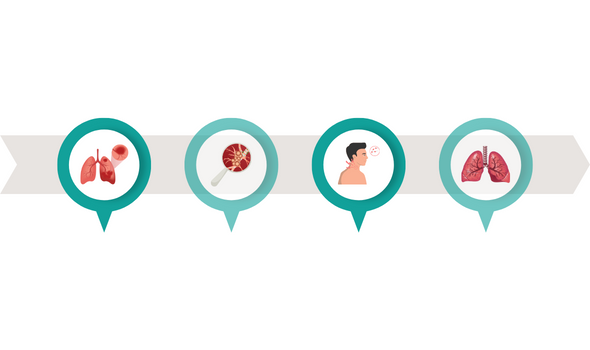What is Lung Cancer and its types?

Lung cancer is a malignant condition that originates in the tissues of the lungs. It is characterized by the uncontrolled growth of abnormal cells, which can invade nearby tissues and spread to other parts of the body through the bloodstream or lymphatic system. Lung cancer is predominantly caused by smoking, but it can also occur in non-smokers due to factors such as exposure to secondhand smoke, air pollution, genetic predisposition, and occupational hazards.
There are two main types of lung cancer: non-small cell lung cancer (NSCLC) and small cell lung cancer (SCLC). NSCLC is the most common type, accounting for around 85% of cases. It is further classified into three subtypes: adenocarcinoma, squamous cell carcinoma, and large cell carcinoma. SCLC is less common, but it tends to grow and spread more aggressively. Each type of lung cancer requires specific treatment approaches, emphasizing the importance of early detection and personalized care.


Lung Cancer Stages:

Lung cancer is staged based on the extent of its spread. The stages range from stage 0 (localized cancer) to stage IV (advanced cancer that has spread to distant organs). Staging helps determine the appropriate treatment options and prognosis for individuals with lung cancer.
There are four main stages in NSCLC:
Non-small cell lung cancer (NSCLC) is typically staged into four main stages: Stage I, Stage II, Stage III, and Stage IV. Stage I NSCLC is localized to the lung and has not spread to nearby lymph nodes. Stage II NSCLC has spread to nearby lymph nodes or invaded nearby structures. Stage III NSCLC has spread to lymph nodes in the middle of the chest or to nearby structures. Stage IV NSCLC is metastatic, meaning it has spread to distant organs or tissues. The stage of NSCLC helps guide treatment decisions and determine the prognosis.
Symptoms of Lung Cancer:
Symptoms of lung cancer can vary depending on the stage of the disease and individual factors. In the early stages, lung cancer may not cause noticeable symptoms. However, as the cancer progresses, several common symptoms may manifest.
Persistent cough is a prominent symptom, particularly if it worsens over time or produces blood. Shortness of breath, wheezing, and chest pain are also common symptoms, indicating potential lung obstruction or inflammation. Unexplained weight loss, fatigue, and loss of appetite may occur due to cancer-related metabolic changes. Recurrent respiratory infections, such as bronchitis or pneumonia, may also occur.
Advanced stages of lung cancer can cause additional symptoms. These include hoarseness, difficulty swallowing, swelling in the face or neck, and persistent headaches. Bone pain, joint pain, and back pain may arise if the cancer has spread to the bones. If the cancer spreads to the brain, neurological symptoms like seizures, confusion, and weakness can occur.
It is important to note that these symptoms are not exclusive to lung cancer and can be caused by other conditions. Nevertheless, if any of these symptoms persist or worsen, it is crucial to consult a healthcare professional for an accurate diagnosis and appropriate treatment.
Causes of Lung Cancer:
The primary cause of lung cancer is smoking, but it can also be caused by exposure to secondhand smoke, air pollution, genetic factors, and occupational hazards like asbestos and radon.
What happens during smoking?
When a person smokes, they inhale a mixture of toxic chemicals into their lungs. These chemicals, such as nicotine, tar, and carbon monoxide, can cause damage to the delicate tissues of the lungs. Over time, smoking leads to the buildup of tar, which coats the lungs and impairs their ability to function properly. It also damages the cilia, tiny hair-like structures that help remove mucus and foreign particles from the lungs. Smoking increases the risk of developing various respiratory conditions, including lung cancer, chronic obstructive pulmonary disease (COPD), and emphysema.
The other factors for lung cancer are:
Apart from smoking, other factors that can contribute to the development of lung cancer include exposure to secondhand smoke, environmental factors such as air pollution and radon gas, genetic predisposition, occupational hazards like asbestos and certain chemicals, previous radiation therapy, and a history of lung diseases such as tuberculosis or chronic obstructive pulmonary disease (COPD). These factors, either individually or in combination, can increase the risk of developing lung cancer.
Lung Cancer Diagnosis:
The diagnosis of lung cancer typically involves several steps. It begins with a thorough medical history and physical examination by a healthcare professional. Imaging tests, such as chest X-rays, computed tomography (CT) scans, or magnetic resonance imaging (MRI), are commonly used to visualize the lungs and detect any abnormal growths or tumors.
If suspicious findings are present, further diagnostic procedures may be conducted. A biopsy is often performed to obtain a tissue sample for laboratory analysis. This can be done through various methods, including bronchoscopy, needle biopsy, or surgical biopsy.
The tissue sample is examined by a pathologist who determines the presence and type of cancer cells. Additionally, molecular testing may be done to identify specific genetic mutations or biomarkers that can guide treatment decisions. A staging evaluation is also conducted to determine the extent of cancer spread.
Other tests, such as blood tests, pulmonary function tests, and positron emission tomography (PET) scans, may be utilized to assess lung function, identify potential metastasis, or evaluate overall health before proceeding with treatment. A multidisciplinary approach involving various specialists is often employed to ensure an accurate diagnosis and develop an appropriate treatment plan.
Treatment of Lung Cancer:
The treatment of lung cancer depends on several factors, including the stage of the cancer, the type of lung cancer, and the individual’s overall health. Treatment options may include surgery, radiation therapy, chemotherapy, targeted therapy, immunotherapy, or a combination of these approaches. The goal of treatment is to remove or shrink the tumor, eliminate cancer cells, and improve overall survival and quality of life. Treatment plans are often personalized and may involve a multidisciplinary team of specialists.
The treatment for NSCLC depends from person to person, and on the health details of an individual.
The treatment for non-small cell lung cancer (NSCLC) varies from person to person and is influenced by individual health factors. Factors such as the stage of the cancer, the presence of specific genetic mutations, overall health, and patient preferences all play a role in determining the appropriate treatment approach. Treatment options for NSCLC can include surgery, radiation therapy, chemotherapy, targeted therapy, immunotherapy, or a combination of these modalities. Personalized treatment plans are designed to provide the best possible outcome for each individual with NSCLC.
When to seek a Doctor’s advice?
It is important to seek a doctor’s advice when experiencing persistent or worsening symptoms, sudden or severe pain, unexplained weight loss, or concerning changes in bodily functions.
Quick Contact
Address
70, 46, Patel Marg, opposite Rastogi Gas Agency, Mansarovar Sector 7, Agarwal Farm, Sector 9, Mansarovar, Jaipur, Rajasthan 302020
deveshkanoongo0701@gmail.com
Phone No.
9024605799, 9414774975
